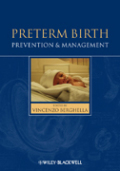
This book provides a clinically focused and practical approach to the prevention and management of preterm birth, using the best available evidence to provide guidance in patient care. Each chapter features key points at the beginning, a quick summary of the evidence-based literature, easy-to-use clinical guidelines, and chapter summaries. Preterm Birth: Prevention and Management will help you to minimize the risk of preterm birth and to manage preterm birth effectively, increasing the chance of a favorable outcome for both mother and child. Vincenzo Berghella, MD, Professor of Obstetrics and Gynecology, Director of Maternal-Fetal Medicine, Department of Obstetrics and Gynecology, Jefferson Medical College, Thomas Jefferson University, Philadelphia, PA, USA. INDICE: Introduction.[audience; prevention; evidence-based; clinical; summary; easy-to-use; benefits (include legal etc -see my introduction)] (V Berghella).1. Impact of Preterm Birth The global burden of PTB (M Merialdi).[number one cause of perinatal morbidity and mortality; economic burden; implications for future generation(s); social burden; etc] (Kramer).2. Preterm birth as a complex disease.[comparison to coronary artery disease; explanation that preterm birth is a final common pathway of several mechanisms; therefore explain that one cure won’t be the answer, but specific etiologies must be identified andspecifically treated; for example, cerclage may work only in women with BOTH prior PTB and short CL; etc] (Lockwood).3. Why prevention.[Explain differencesbetween primary, secondary, and tertiary prevention; explain why primary prevention is superior; explain why chapters divided by risk factor, not by intervention per se (e.g. chapter on “Prior PTB” versus chapter on “Cerclage” - tailor intervention to individual patient); etc] (Baxter; fellows; V Berghella).4.Epidemiology of preterm birth. [Review risk factors (use tables - include sex, lifestyle issues, physical and sexual abuse; etc); explain why preterm birthmay be also a political issue: poverty, race, etc; introduce concept of pathways to preterm birth] (Goldenberg).5. Biology of term versus preterm labor. [Differences between term and preterm birth, with clues into how these differences would help prevention of preterm birth; basic mechanisms of cervical ripening and uterine contractions] (Peter Nathaniels).Pathways to PTB.6. Genetic . [review latest data on genetic links to preterm birth] (Hy Sigham, M Merialdi).7. The cervix.[mechanisms associated with cervical disease - structural, functional - and PTB; matrix biology; relation to abnormal anatomy (LEEP, D&E, etc), inflammation, infection, contractions, etc; cervical insufficiency as a continuum with PTL, PPROM (V Berghella and fellows). 8. Inflammation and Infection.[proteinomics; incidences of infection by amniocentesis in different populations (table); etc] (R Romero). 9. Endocrine.[include stress, psychological and behavioral; undernutrition, relaxin, etc] (Hobel).Clinical Guidelines. Primaryprevention. 10. Preventive issues for all gravidas. [preconception and prenatal care centered on prevention of PTB: accurate history, physical exam. What works: nutrition, exercise, weight and weight gain; avoiding life style risks; screen for asymptomatic bacteriuria; sex; public health interventions; family planning; scoring systems (Creasy etc); what does not seem to work and why - HUAM, support, etc] (V Berghella). 11. Smoking (J Tolosa). Secondary prevention(according to risk factor - in order of prevalence-impact).12. Prior preterm birth. [progesterone; cerclage, bed rest, support, exams, antibiotics, omega-3fatty acids; etc] (J Iams). 13. Short cervical length. [progesterone, cerclage, etc] (V Berghella). 14. Fetal fibronectin (Andrews). 15. Bacterial vaginosis (Klebanoff). 16. Sexually transmitted infections .[trichomonas, chlamydia, gonorrhea, syphilis, HIV, etc (Silverman; M. O’Neill).17. Low maternal weight.18. Multiple gestation.[prevention of multiple gestations thought improvements in assisted reproductive technologies (including legislation); bed rest, multifetal reduction, cerclage, progesterone, HUAM, etc] (Hayes).19. Others.[multiple D&Es; cone biopsy; mullerian anomalies; “high-risk PTB”; cervical dilatation/cervical insufficiency; periodontal disease; other infections (GBS, mycoplasma/ureoplasma); etc] (Pereira). Tertiary prevention.20. Asymptomatic cervical changes.[presentation (incidental); work-up (amniocentesis, etc); cerclage; progesterone; pessary; etc] (Leo Pereira).21. Preterm labor. [diagnosis (CL, FFN); assessment; laboratory tests; steroids; transfer to tertiary care-center (importance of regionalization); tocolysis (details for all 6 classes; divide byprimary, refractory; maintenance); non-effective interventions (hydration ; antibiotics ; bed rest; HUAM; etc - include special section on multiples; anesthetic issues; what to do once PTL resolves] (Amen Ness) from my Spong chapter.22. Preterm premature rupture of membranes. [diagnosis; assessment; steroids;tocolysis; antibiotics ; non-effective interventions (hydration; bed rest; etc) - include special section on multiples] (Mercer; Seibel-Seamon). 23. Induced preterm birth. [include when PTB is a good thing - include specials section on multiples].24. Promotion of fetal maturation.[steroids (include why / when / how / how often they should be given) TRH; Phenobarbital; vitamin K; etc] (Wapner).25. Place, mode of delivery and post-partum.[advantages of delivering in tertiary care centers; include RCTs; risk of recurrence; care of future pregnancy; inter-pregnancy management; etc].26. Neonatal care and long-term implications.[importance of NICU care; clinical guideline for support of the pretermneonate; make reference to obstetrical care issues; decreased IQ; decreased chance of getting married; etc].27. Special issues for the developing world.[infectious- and poverty-related preterm birth more common; malaria; etc] (M Merialdi).28. Ethical and psychological issues related to preterm birth.[peri-viable period: deliver or abort?; include psychiatric issues, family strees, marital discord etc] (Chervenak; Caplan).29. Future Research.[what lines of research should be followed; basic science (proteinomics etc); clinical trials; social interactions; funding available; etc] (J Tolosa).30. Appendix A: Informationfor patients
- ISBN: 978-1-4051-9290-3
- Editorial: Wiley-Blackwell
- Encuadernacion: Cartoné
- Páginas: 304
- Fecha Publicación: 19/01/2010
- Nº Volúmenes: 1
- Idioma: Inglés
